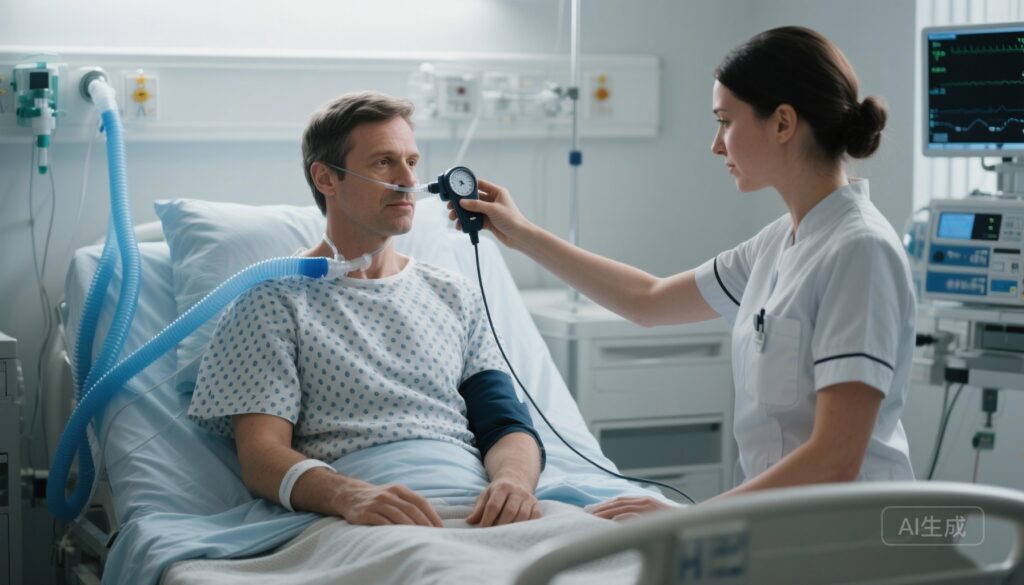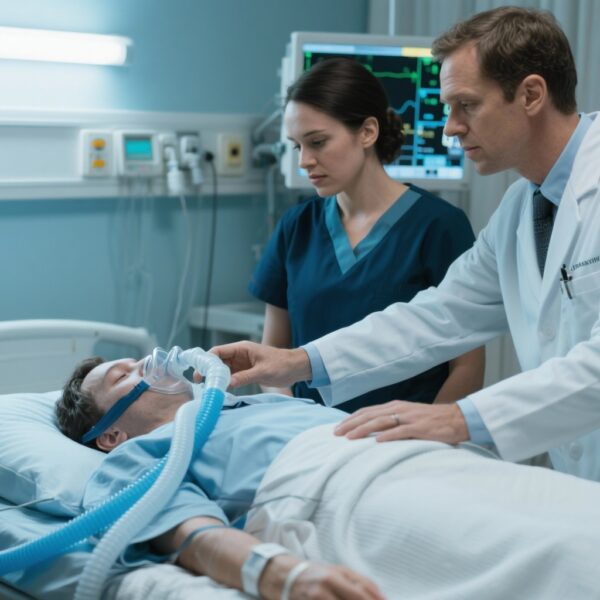Highlight
– Persistent inspiratory muscle weakness (IMW; MIP ≤ 30 cmH2O) after prolonged mechanical ventilation is common, observed in 43% of patients at acute-care discharge in a prospective multi-center Swiss cohort.
– A single bedside measure — maximal inspiratory pressure (MIP) obtained 12 days after IMW diagnosis — and the change in MIP from inclusion to day 12 were strongly associated with persistent IMW.
– Early identification (around day 12) of patients at high risk for persistent IMW may allow targeted respiratory physiotherapy, inspiratory muscle training, and planning for post-acute care needs.
Background
Prolonged invasive mechanical ventilation (MV) is a major driver of respiratory muscle dysfunction and generalized ICU-acquired weakness (ICU-AW). Diaphragm unloading during MV induces rapid atrophy and contractile dysfunction (ventilator-induced diaphragmatic dysfunction), while systemic critical illness and immobility contribute to peripheral muscle loss. Impaired inspiratory muscle function prolongs weaning, increases the risk of reintubation, and impairs functional recovery after hospitalization.
Clinically feasible bedside tools to detect and monitor inspiratory muscle performance include maximal inspiratory pressure (MIP) and global strength measures such as the Medical Research Council (MRC) score. However, the natural history of inspiratory muscle recovery after prolonged intubation and the early predictors of persistent impairment during the acute-care hospital stay are not well defined. The study by Oestreicher et al. addresses this gap by prospectively following extubated patients with documented IMW to the end of the acute-care stay and exploring early MIP measurements as predictors of persistent weakness.
Study design
This exploratory prospective observational study enrolled adult ICU patients from five Swiss hospitals who were extubated after ≥7 days of invasive MV and had inspiratory muscle weakness (IMW) diagnosed within 48 hours of planned extubation (defined a priori as MIP ≤ 30 cmH2O). Patients were followed throughout the acute-care hospital stay with serial measurements of MIP and MRC score and collection of baseline characteristics and ICU-related exposures (duration of MV, sedation, vasoactive drugs, ICU-AW recorded in the chart, reintubation, ICU readmission, hospital mortality).
Missing MIP values were treated using linear interpolation. Associations between baseline/early variables and persistent IMW at study completion (again defined as MIP ≤ 30 cmH2O) were tested using univariable logistic regression. In addition, a random forest model was applied to identify the optimal timepoint for MIP to predict persistent IMW.
Key findings
Population and overall outcome
Sixty-nine patients (48 men, 21 women) completed the study. At the end of the acute-care hospital stay, 30 patients (43%) had persistent IMW (MIP ≤ 30 cmH2O). Median MIP at study completion was 22 cmH2O (interquartile range [IQR] 13–24) in the persistent IMW group versus 44 cmH2O (IQR 36–64) in those who recovered above the threshold. These results indicate that nearly half of patients with documented early post-extubation IMW remained weak through acute-care discharge.
Predictors and timing
In univariable analyses, persistent IMW was positively associated with female sex and with indices of greater illness severity or therapy intensity, notably duration of catecholamine use up to inclusion. Importantly, MIP measured at day 12 after inclusion and the change in MIP from inclusion to day 12 were both strongly associated with persistent IMW at study completion. MRC score at day 12 was also associated. Intriguingly, the presence of pre-existing respiratory comorbidities was negatively associated with persistent IMW, a finding that may reflect selection bias, different baseline training of respiratory muscles, or confounding by indication.
The random forest analysis identified day 12 MIP as an optimal early predictor of later persistent weakness, supporting the clinical utility of a single measurement at that timepoint to stratify recovery trajectories.
Safety and clinical events
The study recorded ICU readmissions, reintubations, and hospital mortality, but the report focused on functional respiratory outcomes rather than safety signals attributed to the measurement process. There was no suggestion that bedside MIP assessment in this context was harmful; MIP is an effort-based, noninvasive test routinely used in weaning assessments.
Expert commentary and interpretation
Clinical significance
This study highlights that IMW identified immediately after extubation in patients ventilated for ≥7 days often persists through the acute-care stay. The high proportion (43%) with persistent weakness has practical implications: patients are likely to require intensified physiotherapy, prolonged respiratory support or supervision, and careful discharge planning including rehabilitation or step-down resources. Identifying those unlikely to recover spontaneously is therefore clinically valuable.
Why day 12 matters
The finding that MIP at day 12 (and the trajectory from baseline to day 12) predicts persistent weakness is plausible from a pathophysiological standpoint. Inspiratory muscle recovery requires reversal of disuse atrophy and reconditioning; a lack of substantive improvement by ~2 weeks may indicate either severe muscle injury or ongoing contributors (inflammation, steroid exposure, inadequate nutrition, ongoing sedation, or continued deconditioning). A standardized checkpoint at roughly 12 days post-diagnosis offers a pragmatic window to escalate targeted interventions.
Measurement considerations
MIP is simple and accessible but has limitations: it is effort-dependent, requires patient cooperation and cognitive capacity, and can be influenced by pain or fatigue. The MRC score similarly requires patient participation and may be biased in patients with delirium or pre-existing neurological disease. The authors’ approach is pragmatic for an acute-care environment but awareness of these measurement constraints is essential when applying the findings clinically.
Comparison with prior literature
The study’s observations align with established concepts: ventilator-induced diaphragmatic dysfunction causes rapid loss of diaphragm force within days of controlled MV (Levine et al., NEJM 2008), and ICU-AW is a common contributor to prolonged disability after critical illness (Hermans & Van den Berghe, Crit Care 2015). The current work extends these observations by providing a time-based, bedside predictor for sustained inspiratory weakness that may be actionable during the same admission.
Limitations and generalizability
Important limitations temper interpretation. The cohort was modest in size (n=69) and derived from five centers in one country, which may limit external validity. The analysis reported is univariable; confounding by covariates such as age, baseline frailty, cumulative corticosteroid exposure, or nutritional status is possible and not adjusted for. Missing MIP values were handled by linear interpolation — a reasonable approach for exploratory work but one that can introduce bias. Finally, the negative association between pre-existing respiratory disease and persistent IMW should be considered hypothesis-generating rather than conclusive.
Implications for practice and research
Clinicians working in post-extubation care can consider routine MIP measurement early after extubation and specifically at ~12 days to identify patients at high risk for persistent weakness. This identification could trigger predefined pathways: referral to respiratory physiotherapy, evaluation for inspiratory muscle training (IMT), optimization of nutrition, review of medications that impair muscle recovery, and early engagement of rehabilitation or post-acute services.
Prospective interventional studies are needed to test whether targeting patients identified by low day-12 MIP with structured rehabilitation or IMT improves functional outcomes, reduces readmissions, or shortens the time to independence in activities of daily living.
Conclusion
Oestreicher et al. provide clinically relevant, prospective data that persistent inspiratory muscle weakness is common among patients extubated after prolonged MV and that a bedside MIP measurement at 12 days after diagnosis is strongly associated with failure to recover inspiratory strength during the acute-care stay. The result supports using day-12 MIP as an early stratification tool to guide rehabilitation intensity and discharge planning while underscoring the need for controlled trials testing targeted interventions in high-risk patients.
Funding and clinicaltrials.gov
The published article (Oestreicher V et al., Crit Care 2025) did not report additional funding details within the summary provided here. No clinicaltrials.gov identifier was reported in the supplied abstract. Readers should consult the full article for declared funding sources or trial registration.
References
1. Oestreicher V, Hennemann M, Hilfiker R, Faivre T, Zoni G, Demont M, Teixeira M, Ucchino R, Tassaux D, Piquilloud L, Contal O. Persistent inspiratory muscle weakness among extubated patients after prolonged intubation is frequent and can be predicted early by maximal inspiratory pressure measured 12 days after its initial diagnosis: a prospective observational study. Crit Care. 2025 Nov 7;29(1):477. doi: 10.1186/s13054-025-05718-8.
2. Levine S, Nguyen T, Taylor N, et al. Rapid disuse atrophy of diaphragm fibers in mechanically ventilated humans. N Engl J Med. 2008;358(13):1327–1335.
3. Hermans G, Van den Berghe G. Clinical review: Intensive care unit-acquired weakness. Crit Care. 2015;19:274.
4. Laghi F, Tobin MJ. Disorders of the respiratory muscles. Am J Respir Crit Care Med. 2003;168(1):10–48.
5. Boles JM, Bion J, Connors A, et al. Weaning from mechanical ventilation. Eur Respir J. 2007;29(5):1033–1056.
AI image thumbnail prompt
Photorealistic hospital scene: a middle-aged adult recently extubated sitting at bedside while a respiratory physiotherapist measures maximal inspiratory pressure with a handheld manometer; background shows ICU bed, ventilator tubing and subtle monitors; warm clinical lighting, focused composition, high-resolution, patient and clinician expressions neutral and professional.


